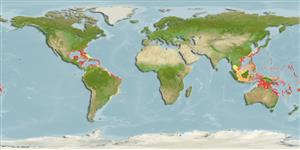Demospongiae |
Haplosclerida |
Callyspongiidae
Environment: milieu / climate zone / djupintervall / distribution range
Ekologi
Revassocierade; brackvatten; djupintervall 2 - 70 m (Ref. 108813). Tropical
Western Atlantic and Western Central Pacific.
Length at first maturity / Size / Weight / Age
Könsmognad: Lm ? range ? - ? cm Max length : 30.0 cm H hane/ej könsbestämd; (Ref. 415)
Cylindrical, to funnel shaped tubes: 5 - 30 cm high, 1 - 10 cm diameter, 1 - 10 cm thick. Gray color with golden, pink or greenish tinges. Surface smooth or with thorn like conules up to 1 cm high, 0.3 - 1 cm apart. Compressible and elastic (Ref. 415).
Common on reefs (Ref. 415) and hard bottoms where coral is not dense in depths between 2 to 70 m (Ref. 85482). Also found in mangroves (Ref. 86836). In Belize, it was found in a submarine cave near Columbus Cay (Ref. 87209).
Life cycle and mating behavior
Könsmognad | Reproduktion | Lek | Eggs | Fecundity | Larvae
Members of the class Demospongiae are hermaphroditic. Life cycle: The zygote develops into parenchymella larva (free-swimming) before settling down on a substrate where it grows into a young sponge.
Collin, R., M.C. Díaz, J. Norenburg, R.M. Rocha, J.A. Sánchez, M. Schulze, A. Schwartz and A. Valdés 2005 Photographic identification guide to some common marine invertebrates of Bocas Del Toro, Panama. Caribbean Journal of Science. 41(3):638-707. (Ref. 415)
IUCN Red List Status
(Ref. 130435: Version 2025-1)
CITES status (Ref. 108899)
Not Evaluated
Not Evaluated
Threat to humans
Human uses
| FishSource |
Verktyg
Ytterligare information
Trophic EcologyFood items (preys)FödosammansättningFödointagPredatorer Population dynamicsTillväxt
Max. ages / sizes
Length-weight rel.
Length-length rel.
Length-frequencies
Mass conversion
Abundans
PhysiologySyreförbrukning
Human RelatedStamps, coins, misc.
Internet-källor
Estimates based on models
Preferred temperature
(Ref.
115969): 22.8 - 28.5, mean 26.7 (based on 584 cells).
Fishing Vulnerability
Low vulnerability (20 of 100).
Price category
Unknown.
